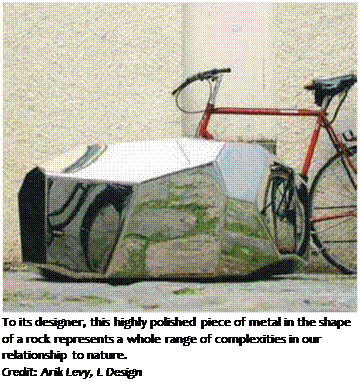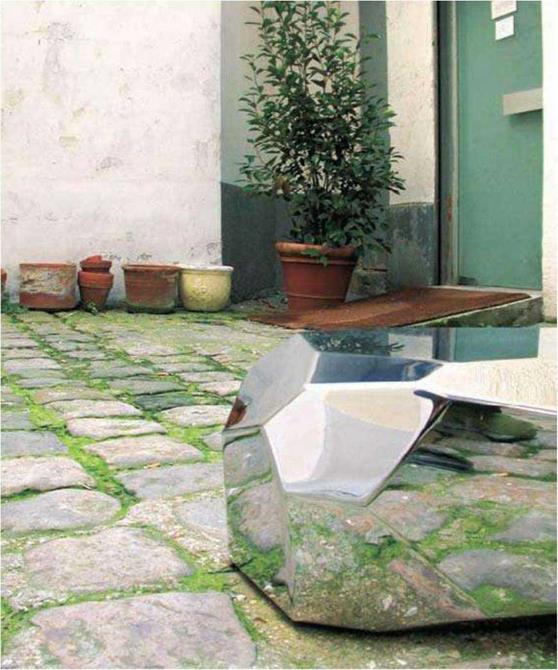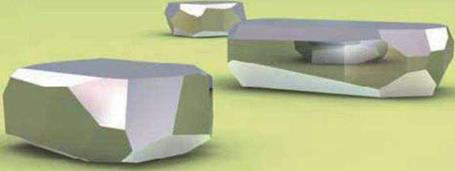 between something which is open and closed, between something solid and soft, and something which appears and disappears as it reflects it’s environment.”
between something which is open and closed, between something solid and soft, and something which appears and disappears as it reflects it’s environment.”
It’s hard to say exactly what Rocks is or are. Perhaps it is a bench, or a seat, or a piece of garden sculpture. Most simply, they are highly polished pieces of metal made to resemble the shape of a hunk of stone. But for Levy, they represent an almost ironic, or at least complex, relationship between humanity and the natural world. “When you have it at home, say as a sculpture or low coffee table or bench, you make what you want out of it,” he says. “You bring a visual representation of notions that we know out of nature. When you bring this home, it reflects the home environment, it becomes part of the people and the interior design and the atmosphere. At the same time, it makes you feel something about nature, but it’s a scientific and metaphoric nature.” He continues, “Then, when it’s outside, it brings the idea of man doing something, it brings this idea outside, among the rocks or the garden or at the swimming pool or on the roof.”
To enhance this dichotomous vision, Levy focused his design efforts on the quality and size of the surfaces. “This feels like an object that has been sculpted, rather than a big rock that has broken off,” he notes. “It’s the proportion between the facets, the dimension of each facet, that fills in and creates the invisible rest of the object that will stay in the mind of someone.” Levy explains that this notion of seeing what has been left out is critical to understanding the visceral impression created when you behold one of his Rocks. “If you look at a hand without a finger, you complete the hand. When you look at this, it has quite a bit of straight and horizontal surfaces and the eye wants to complete the cube. You’ll see what was taken off more than what was left behind, because it’s closer to the action. What you see is not the cube, but what’s left. You see the contact surface of what was taken off. It’s not that you see the cube, but you want to complete it in your mind. We look for the continuation of the surfaces. It’s like typography—the words are actually read by seeing the space that’s left around them.”
What Levy wants people to see is not just the space from which the object may have been created, but also the environment from which the whole notion of the piece was derived. “If I make something that makes someone feel—for example, you can feel nature even if you’re not seeing it, you feel the sense of rock before you’ve touched it—I send you to an emotional experience. This is one of the big successes of these pieces.”
To create this complete sensory experience, Levy did some very basic and hands-on work. “I begin with, I went to the office on
|
128 DESIGN SECRETS: FURNITURE |
|
A sketch shows the facets and sculptural quality of the natural object that interested the designer, which he sought to re-create in a more ironic and challenging material.
 Credit: Arik Levy, L Design
Credit: Arik Levy, L Design
 |
This sketch shows the designer exploring the relationship of the shapes, sizes, and angles of the facets to one another, as well as the tension that is created between two objects placed together. Credit: Arik Levy, L Design
Sunday, went to the workshop, took a few pieces of foam, ground them, and looked at it and ground it again, and looked at it again, and then said, ‘That’s it.’ ” Once he had this physical object, he and his staff created a three-dimensional file on the 3D modeler, and scaled it up to real size. Then, they created a kind of map of the image that could be laid flat and then folded back up into the desired shape. These files were sent to a workshop that specializes in custom bars and railings, what Levy refers to as “impossible stainless steel work.” They laser cut 3mm (ir")- thick stainless steel sheets, following the map. Levy explains that where the surfaces change orientation, about half are banded, or folded, and about half are welded. “Not all parts are on a connecting axis,” he notes. “When you have parts where there are three or five axes, you have to cut and paste, as it were.” After the metal has been folded and welded, it is ground and polished to a mirror finish. “It reflects its environment,” Levy says, “and makes things look soft or hard or empty or full.”
Each Rock is handmade and totally empty inside. At the workshop, “They didn’t even ask what is it,” Levy recalls. “This was so odd, they didn’t even ask. I said it has to be like this, and they just said, okay, okay, okay. Then they started making it and, just fell in love with it. It has an emotional relationship to them. It was very beautiful that people that are cutting and welding metal suddenly become emotional about an object that is not part of their own culture.”
The Rocks come in three different sizes, and weigh about 30, 18,
1 1
and 12 kilos (13 Ту 8, and 5 т lb.) each. Levy sees them working together, but is not prescriptive as to how. “They could be grouped, or used as just one or two. How you position them one next to the other, that is done intuitively because you create tension between the sizes. There’s no single orientation, there is no one right orientation; there are many different ones. Because it is such an all around object, you can use it in many different ways. I don’t suggest any particular thing.” Levy clearly enjoys the confusion and intrigue created by coming upon a highly polished rock that appears to have fallen from a passing space ship. “I like the looks people give it,” he says. “Some people just say, ‘Wow I want it.’ Some people come up, and we have a really nice discussion. It’s like a jumping off point; it’s not what it is, but what it makes people do or think or talk about.”
The Rocks, no matter which shape or size you’re looking at, defy easy categorization and can hardly be called furniture. It’s a new kind of object that not only reflects, but seems to take on its surroundings. “It’s connected into my more sculptural work,” Levy says. “It’s a really a good example for myself of where design and art meets today, which is a fine blurry border, where an object can have a function without being a bench, and can have an artistic function without being called a sculpture.”
|
|
|
|
Top: Set outside, the Rock reflects its environment, making a statement for the designer about human influence on nature, and also proving to be a fascinating conversation starter. Credit: Arik Levy, L Design
Three-dimensional computer renderings of a group of Rocks show the possibilities imagined by the designer—not only are the pieces sculptural on their own, but they create new tableaus depending upon how they are grouped together.
Credit: Arik Levy, L Design
Opposite: Arik Levy gets a taste of his creation: “It refers to the ‘feel before you see’ idea,” he says, “so when you put it in the mouth, you can feel the form.”
Credit: Arik Levy, L Design
|
130 DESIGN SECRETS: FURNITURE |
|
ROCKS 131





